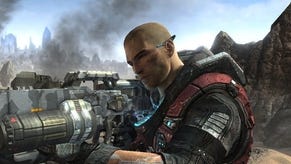Fracture
Painful.
Cliff Bleszinski observed recently that Active Reload is one of the best ideas in the whole of Gears of War, and the fact that nobody's ripped it off is bizarre - especially when you consider how much they have ripped off. Gears may not have invented clip-to-the-wall cover systems, but it certainly popularised them, and even if you discount that, you can't throw a stone without hitting an action game that owes Bleszinski a pint. Fracture certainly does, having nicked the Roadie Run with an almost actionable disregard for variation, and - if that's any indication - the gently concealed data chips you collect and the player-character's crimson barrel-chested armour are also casual lifts.
Fracture doesn't have a cover system though, and that's because its big thing is terrain deformation, and deformed terrain is too curvy and freeform to snap your back to, even if the game's enormous volume of crates, boulders and barrels would be a perfect alternative. Instead you dig instant pits and compose muddy mounds to certain (hard-coded) depths and heights using the 'Entrencher', and the game plays out around this deformation as a standard third-person shooter. The implications are interesting: protect yourself from turrets by erecting makeshift cover, solve puzzles by pushing, steering and burrowing past things with the terrain, and tackle enemies by juggling them into the air and letting rip with your basic arsenal.
Sadly the developers won't leave you to it. Even after a heavy-handed tutorial level, every puzzle solution is the blindingly obvious last step at the end of a narrowing gamespace, or simply highlighted by icons or described by your CO, who barks instructions through an earpiece throughout. Anything that isn't spoilt by design falls down almost immediately because the solution is simple and repetition and clunky mechanics ruin the satisfaction of implementing it, the wrong bit of ground regularly leaping or sagging in response to what seemed like a well-aimed Entrencher blast.

As for combat, your arsenal is surprisingly puny, utilitarian and understocked for long stretches, while enemies are numerous and accurate, so instead of making tactical judgements about how to utilise deformation you either madly spam the floor to carve out a window for your Halo-style overbody shield to recover, or forget about it entirely, only remembering when the Entrencher is upgraded with new functions. Basic mechanics are mishandled, with creaky analogue acceleration meaning it's harder to target your foes than it should be, while the range of enemies is predictable and they rarely react to being shot until they absorb the final bullet, emphasising the grind and removing any sense of pace from firefights, which are either slow, ranged affairs or fierce and frantic up until the last moment.



